The Enduring Legacy of Richard Nelville Hall
Spring 2016:
The Enduring Legacy of Richard Nelville Hall 2
Letter from the AFS International President 7
Snapshots and Stretchers: Burma through My Father’s Eyes 8
The Volunteers: Americans Join World War I, 1914-1919 10

From Trenches to Bridges: 2015 Youth Forum in Alsace 12
AFS WWII Ambulance Drivers Last Post 15
Arthur Howe, Jr. Endowment Fund and Archival Project 16
Dear AFS Friend,
This issue of the AFS Janus features the short life of Richard Hall, the first AFS ambulance driver to be killed during World War I. His story of humanitarianism and brotherly affection demonstrates the symbolism behind the tragedy of his early death, then and now. The article was compiled using letters, documents, stories, and photographs found in the Archives of the American Field Service and AFS Intercultural Programs (AFS Archives), Dartmouth College, the AFS Foundation, and most importantly, from the Hall family themselves.
Richard’s story was also featured in the From Trenches to Bridges youth forum that brought together 200 students from around the world to discuss the challenges that stand in the way of living together peacefully, and to identify solutions as a group. The youth forum has taken on even more meaning in light of recent events. Vincenzo Morlini also touches on these world events in his “Letter from the AFS International President,” and reflects on how the AFS mission can help create a more peaceful world.
Later in the issue, Marion Kinter shares the wartime photographic journey of her father, World War II ambulance driver William Boardman Kinter. William carefully photographed his experience in Burma, capturing daily life for the AFS volunteers and local communities in a world at war, including a series of rare color slides. Through the incredible work of Marion, who painstakingly scanned and cataloged her father’s photographs, the entire collection is now available online!
Finally, we share the exciting news of our groundbreaking public history project titled The Volunteers: Americans Join World War I, 1914-1919, including the launch of our curriculum and the opening of the related exhibition at the premiere World War I museum in the United States.
I encourage you to share the stories in this issue about AFS’s long history of volunteerism with others. Thank you, as always, for your continued support!
The Enduring Legacy of Richard Nelville Hall
by Nicole Milano
Julie Hall stood at a podium in front of a sea of faces; more than 200 high school students stared back at her. “‘A sense of humor and a touch of mirth / To brighten up the shadowy spots of Earth’ is the quote my great-uncle Richard chose for his high school yearbook page, which basically means ‘bring humor and joy into difficult situations to make them easier’,” Julie began. “Richard…was your age when he chose this sentiment as his statement to be remembered by…At 16 years old, years before any thoughts of war, I’m sure he couldn’t possibly imagine that this quote would be read out loud, 106 years after he wrote it, 3,000 miles from where it was written, by one of many great nieces he never knew, at the place where he died while bringing joy and humor into a devastatingly difficult situation.”
Nicole Milano
Head Archivist and Historical Publications Editor nicole.milano@afs.org

AFS Intercultural Programs, Inc.
71 West 23rd Street, 6th Floor
New York, NY 10010-4102 USA
tel: +1.212.807.8686
fax: +1.212.807.1001
www.afs.org

Like Richard Hall, Julie had traveled across the Atlantic to Alsace, France where, a century earlier, her great-uncle and grandfather volunteered as ambulance drivers in an area with mounting injuries in the midst of a devastating war. One hundred years later, AFS students from 43 countries and 16 members of the Hall family gathered in Alsace for the From Trenches to Bridges youth forum to discuss the value and impact of volunteerism from World War I to the present, and the bridges to peace created by volunteers like Richard Hall.

A Young HumAnitAriAn
Richard “Dick” Nelville Hall was born on May 18, 1894 in Ann Arbor, Michigan to Louis and and Elizabeth Douglas Hall. He had one younger sister, Elizabeth, and two older brothers – Douglas
AFS JANUS • SPRING 2016 • 2 1
and Louis. Louis and Richard loved to tinker with cameras and cars in their childhood, taking them apart and putting them back together again. Richard Hall went on to attend the University of Michigan before transferring to Dartmouth College, where he became president of the Rifle Club.
An AFS unit was organized at Dartmouth during his senior year, and Richard’s graduating class was told any man who wished to go to France with this unit could do so. Hall volunteered immediately after graduating in 1915. In a letter to his parents, he stated that “the greatest inducement to going over [to France] is the opportunity for humanitarian work.” While he admitted that working near the front lines would be thrilling, he also understood that there would be many challenges, including being constantly exposed to danger and death. Despite this, he quickly came to the realization that “while one would meet with much that might dishearten him, he would always have the comfort, the reassurance of the fact that he was doing his share, however small, in helping to better the conditions of others.” Inspired by his strong desire to serve humanity, his parents immediately gave their consent for him to go overseas.

Richard was assigned to unit Section Sanitaire [États-] Unis (SSU) 3 in 1915, which included famed Lost Generation artist Waldo Peirce and Stephen Galatti, who would later spearhead the creation of the AFS secondary school exchange program after World War II.



Richard quickly adapted to the difficult work in Alsace. Lovering Hill, the leader of SSU 3, said that Richard became known as its “most refined, likeable, and conscientious” member, “immediately liked by the French people for his sympathy, and respected by the ambulance men for his efficient work.”
Richard’s letters to his family are punctuated with breaks when he would go on trips to pick up the wounded, and return (sometimes days later) to finish the letter. He described a night on guard duty in a letter dated October 13: “I slept on my stretcher in my car in the church yard so as to be on hand for the messenger in case a call comes in the


good sleep.” Although it rained hard that evening, he reassured his parents that he was “cozy enough” and “used to sleeping with my clothes on, and on a stretcher, so that I never lose any sleep on that account.”
Although Richard’s enlistment period ended in November, he continued volunteering because his brother, Louis, was still on duty with AFS in the same unit. The brothers would sometimes go days without seeing each other during the course of their ambulance work. They would occasionally cross paths at a dressing station in the mountains, where they would talk about their experiences. Yet, according to Louis in a letter to his parents, they never discussed their “inmost thoughts,” because serving as eyewitnesses to extensive human
were touched and stirred as they had never been touched and stirred before.”
The brothers had plans to travel around France after their service ended and, according to family lore, hopefully meet some French women. Richard planned to then return home to take up graduate work at the University of Michigan. >>>
 Cover: French stretcher-bearers unloading the wounded from an AFS ambulance at the hospital in Moosch, Alsace.
1. Richard Hall in 1915. Courtesy of the Dartmouth College Archives.
2, 3, & 4. Richard Hall prior to his service with AFS. Courtesy of the Hall family.
5. SSU 3 ambulance drivers wearing gas masks in Alsace in 1915.
Cover: French stretcher-bearers unloading the wounded from an AFS ambulance at the hospital in Moosch, Alsace.
1. Richard Hall in 1915. Courtesy of the Dartmouth College Archives.
2, 3, & 4. Richard Hall prior to his service with AFS. Courtesy of the Hall family.
5. SSU 3 ambulance drivers wearing gas masks in Alsace in 1915.
AFS JANUS • SPRING 2016 • 3 2 3 3 5 4
tHe Bitter FigHt For AlsAce
Richard’s time in Alsace was marked by bitter fighting for possession of Hartmannswillerkopf, a pyramidal rocky spur located in the Vosges Mountains. A historically contested region, Alsace had been taken by Germany in 1870, and the battle for Hartmannswillerkopf demonstrated France’s determination to gain it back. Small Alsatian villages were torn apart by shellfire, and the area was flooded with soldiers.
The winding road the drivers used during the battle for Hartmannswillerkopf was crowded and full of mules, broken artillery carts, straggling pedestrians, and convoys of German prisoners. The muddy road was pocketed with shell holes and rutted by the many wheels, hoofs, and feet that had passed over it. The AFS ambulances were loaded with wounded from the dressing station, and the runs up and down the mountain to retrieve more casualties seemed endless. The drivers slept where they could during busy times – in their ambulances, at the dressing station, and sometimes on the floor of their temporary kitchen near the hospital.
Richard was able to find moments of pleasure in his work amidst the challenges of war. On November 11 he wrote: “It is rather nice to know I can be happy in the face of some hard and dirty work, even with privations.” While he found fulfillment in the work he was doing, the approaching holiday appeared to make him miss home, and he noted: “I am not talking or thinking about Christmas. I don’t dare.”
cHristmAs DAY
Richard befriended the Mueller family in Moosch, who lived near the hospital. Their youngest daughter reputedly made him an omelette à la confiture before he left for his evacuation work on December 25, so that he wouldn’t embark on an empty stomach.
Richard was killed by a German shell on a turn in the road leading to the dressing station at Hartmannswillerkopf in the early morning hours of

Christmas Day 1915. His car was destroyed and swept off the road. Given the darkness of night, a number of fellow ambulance drivers had driven up and down the mountain past his ambulance for hours before he was discovered, his hands still clutching the steering wheel. Only 21 years old, Richard Hall became the first AFS volunteer to be killed during the war.
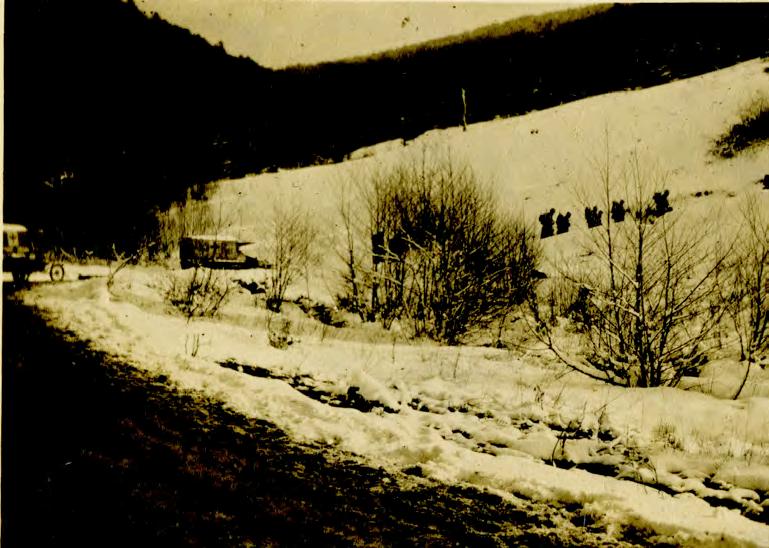

Richard was buried in the first of many rows of graves at the French military cemetery in Moosch, his cross reputedly made from pieces of his shattered wooden ambulance. His coffin was carried to the cemetery by six men, including Lovering Hill and Stephen Galatti, while his older brother Louis walked directly behind. Sixteen soldiers with arms reversed marched in files on each side. His body was covered in the tricolor French flag decorated with the Croix de Guerre before he was lowered into the ground.
In a letter to Hall’s parents, AFS founder A. Piatt Andrew described the memorial service held in Richard’s honor at the American Ambulance Hospital in Neuilly-sur-Seine soon after his burial. Ambulance drivers from the Hospital attended, along with “wounded soldiers, without a leg or without an arm, or with mutilated faces or bandaged heads, wearing the faded uniforms of France.”
An inspirAtion For All
Andrew noted that Richard’s death gave the AFS volunteers “a sense of consecration” in their service, and that it “glorified their work, and…helped to forge tighter the bonds of friendship between the two countries, which represent the best the modern world has to offer. He could not, by living, have contributed so much to the world.” His fellow ambulance drivers wore black arm bands as a sign of mourning on their left arm for weeks after his death, and in newspapers and accounts in the U.S. his death became a symbol of the strong bond between France and the United States.
Despite their sadness, Richard’s death inspired additional humanitarian efforts by members of his family. His father became president of the local Red Cross. His mother went to France the following summer to volunteer as a nurse at the American Ambulance Hospital, which now had a bed dedicated to her fallen son. Before returning to the States, she visited Alsace with her son Louis to see Richard’s grave and to meet the Mueller family, who had been tending to the grave and placing flowers on it since his death.
AFS JANUS • SPRING 2016 • 4 1
Louis continued his volunteer work with AFS, and even drove the ambulance donated in Richard’s name by the women of Ann Arbor, Michigan.

rememBering ricHArD HAll

Two World Wars and a century later, Richard Hall is still the only American buried in Moosch, France. On November 3, 2015, sixteen descendants of Louis Hall gathered in Moosch under a gentle rainfall to pay tribute to Richard and unveil a newly-installed plaquecommemorating his life. The ceremony was attended by the mayor of Moosch, a representative of the U.S. consulate, military personnel, 30 current AFS students, and many other friends and family.

“Richard Hall could not have known exactly what he was signing up for when he volunteered. However, I imagine that what he did know was that people…were suffering and needed help,” Susan Rakitt, Richard’s great-grandniece, told the crowd. “This commemoration reminds me to look for Richard’s humanity and spirit of volunteerism in myself, to advocate on behalf of others
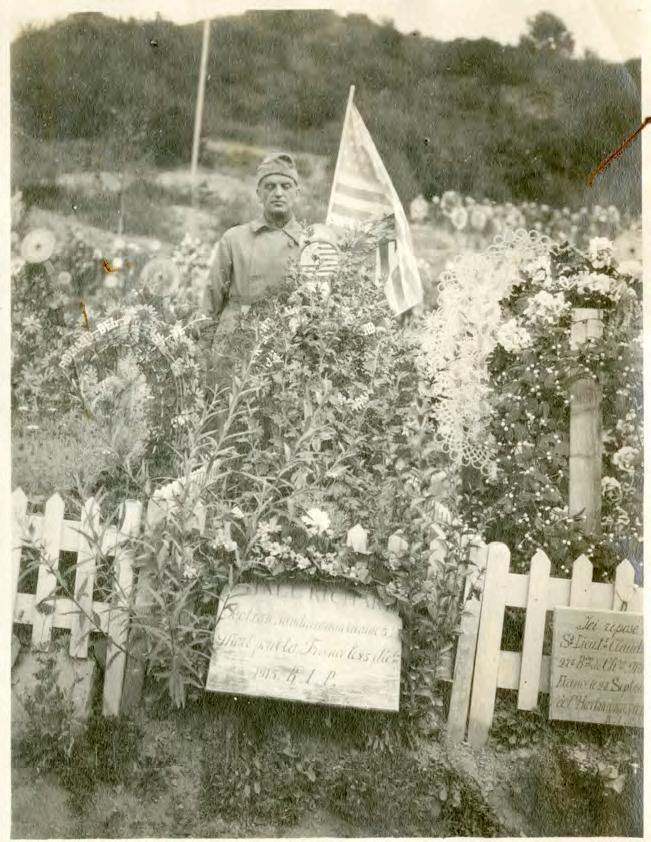 1. AFS ambulances on the road leading up to Hartmannswillerkopf in 1915.
2. Richard Hall, Louis Hall, and fellow AFS driver Tracy Putnam at a car park in Mollau in 1915. Louis married a French woman, Helen Iselin, and lived in France for years after the war.
3. Richard Hall’s destroyed ambulance.
4. AFS founder A. Piatt Andrew at Hall’s grave in Moosch during the war.
1. AFS ambulances on the road leading up to Hartmannswillerkopf in 1915.
2. Richard Hall, Louis Hall, and fellow AFS driver Tracy Putnam at a car park in Mollau in 1915. Louis married a French woman, Helen Iselin, and lived in France for years after the war.
3. Richard Hall’s destroyed ambulance.
4. AFS founder A. Piatt Andrew at Hall’s grave in Moosch during the war.
AFS JANUS • SPRING 2016 • 5 4 3 2
Prior to the ceremony, Susan, Julie, and other members of the Hall family met with Madame Mondon, the daughter of the young woman who made Richard Hall his last meal. The Mueller family never forgot Richard after his death, and continued laying flowers on his grave and tending to the grass for nearly a century. The Hall family gathered in her home that day, sharing experiences and looking at
letters and photographs sent between the families over the years.

Richard Hall was one of many college-aged men who went abroad during the war – some to find adventure, some to simply help others. While his volunteer experience was quite ordinary as wartime volunteer experiences go, the legacy Richard left





represents is unique. For the Hall family, Madame Mondon, the AFS students in attendance at the cemetery, and many others, the plaque perched in a small cemetery on a beautiful hillside in Alsace serves as an enduring reminder of Richard Hall and the ongoing Franco-American friendship. It is also a fitting reminder of the volunteer spirit
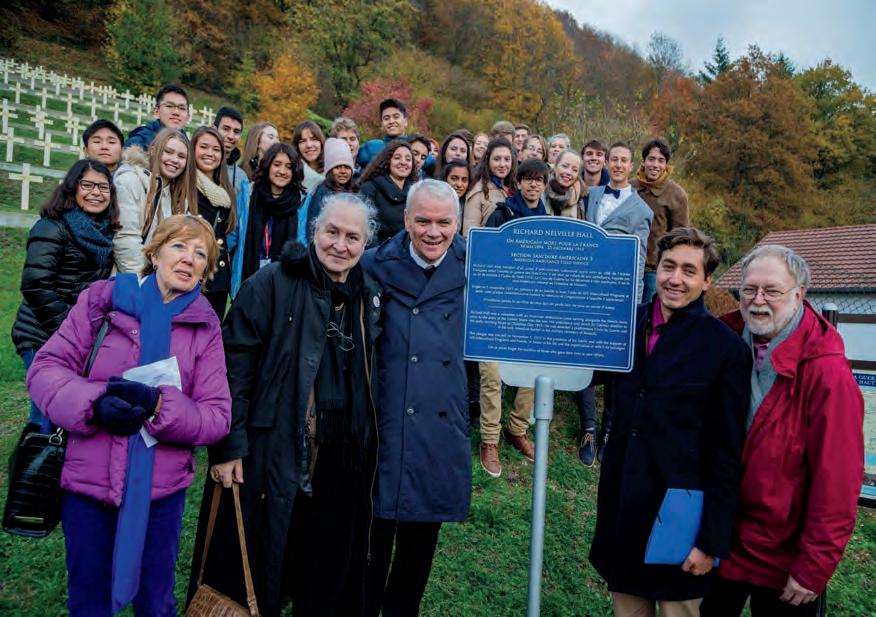
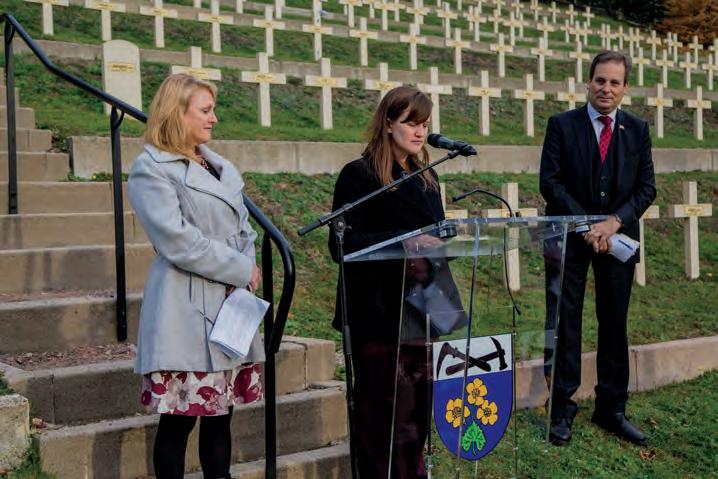
AFS JANUS • SPRING 2016 • 6
1. Susan Rakitt, descendant of Louis Hall, speaking at the military cemetery in 2015. AFS Returnee Philippe Choukroun, who facilitated the plaque unveiling with the town of Moosch, looks on. Photograph by Guillaume Kerhervé. Courtesy of AFS Vivre Sans Frontière.
2. Julie Hall (kneeling, center) and fifteen other members of the Hall family were in attendance at both the plaque unveiling and AFS youth forum held in France in November 2015.
2 4 1
3. AFS students, alumni, and friends unveil the newly-installed plaque for Richard Hall in Moosch on November 3, 2015. The plaque was generously supported by AFS International, Cercle des Amis AFS, Mick and Camille Vandeberg, AFS Alumni DK, Christian Werle, and an anonymous donor.
Letter from the AFS International President
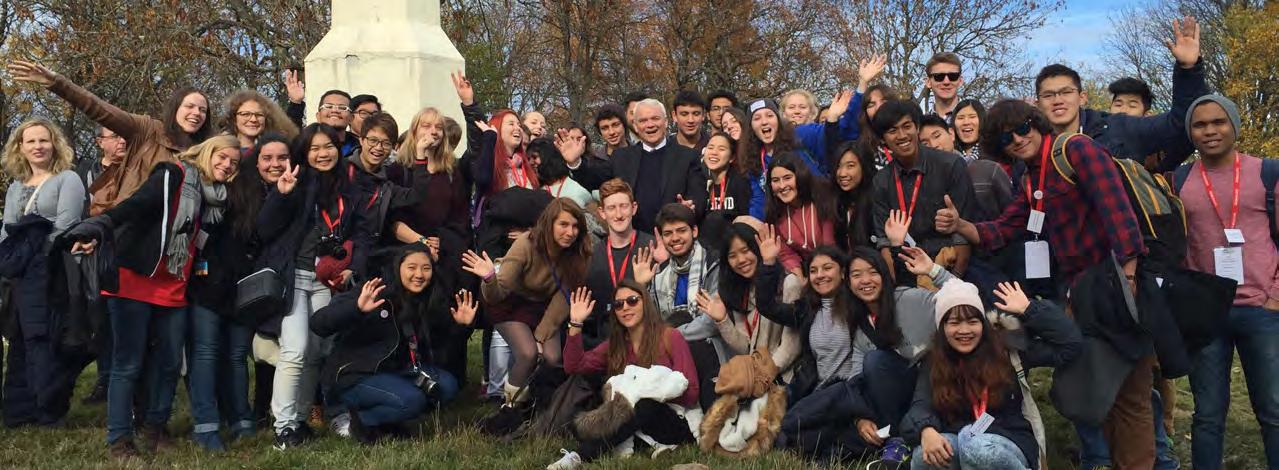
In conjunction with the continuing centennial celebrations of World War I, this issue of the AFS Janus highlights how AFSers of today are commemorating the AFS volunteers from World War I. The stories of these individuals who acted on the zeal and spirit of volunteerism 100 years ago have led me to reflect on how AFS has changed and grown over the past century, and ask: who are the ambulance drivers of today?
Today we are all affected by a world experiencing not a world war, but acts of terrorism and conflicts that cause huge migrations of people. We are confronted with the issues caused by refugees being forced to leave their homelands to look for better places for their families and futures. They dare to migrate despite many challenges in the process, and face additional challenges when integrating into new cultures in countries foreign to them.
William Lacy Swing, Director General of the International Organization for Migration, stated on December 18, 2015 (International Migrants Day) that:
2015 will be remembered as a year of human suffering and migrant tragedies. Over the past 12 months, over 5,000 women, men and children lost their lives in search of protection and a better life. Tens of thousands more have been exploited and abused by human traffickers. And millions have been made into scapegoats and become the targets of xenophobic policies and alarmist rhetoric.
What can AFS do in response to this situation that affects us all? We are not an organization that can provide logistical support or resources for shelter and immediate assistance, but we do know how to develop mutual understanding between cultures and offer learning opportunities so that we can all live together peacefully.
For almost 70 years, AFS has been a leader in education and has the expertise and experience in working with school systems around the world. AFS International developed a proposal that uses our collective strengths to address some of the issues being faced by schools operating with new, unfamiliar, and often challenging realities due to the crisis. We believe that because of our expertise in fostering intercultural dialogue and cross-cultural competence, our hands-on relationships with schools and local communities, plus the grassroots nature of our volunteer base, AFS is uniquely positioned to help schools in hosting displaced students.
We need to understand and develop what kind of intervention and investment we can offer these schools to help them confront the issues they are all experiencing by accepting children of refugees. We need to be the “ambulance drivers” of the 21st century, addressing the challenges of today’s society and honoring the legacy of our founders in striving for a more just and peaceful world.
Vincenzo Morlini President and CEO, AFS Intercultural Programs, Inc.
AFS JANUS • SPRING 2016 • 7
Above: Vincenzo Morlini (center) with AFS participants and volunteers at the From Trenches to Bridges youth forum held in Alsace, France in November 2015.
Snapshots and Stretchers:
Burma through My Father’s Eyes
My father, William “Bill” Boardman Kinter, was an AFS ambulance driver in Burma during World War II. Only 18 years old when he departed New York in November 1944 on the S.S. Pomona Victory, he was posted to the 14th Army in January 1945 with AFS unit IB 43.
While in Burma he continued to pursue his interest in photography, and developed black and white photographs in the back of his ambulance by the light of a kerosene lamp. He also had a roll of 35mm Kodachrome film, which he swapped in and out of the camera, producing
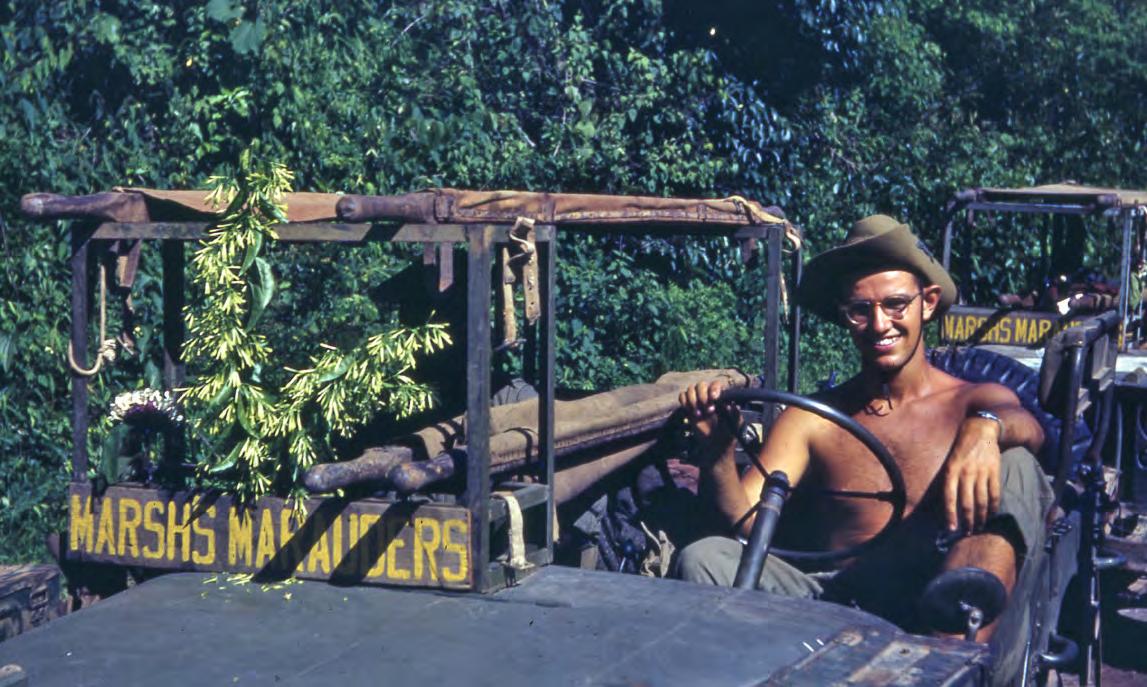 by Marion A. Kinter
by Marion A. Kinter
remarkable and rare color slides from the spring, summer, and fall of 1945. Through his lens he captured fellow AFS volunteers and military colleagues at war, depicting life in the field, as well as everyday life of the Burmese–their culture, architecture, and geography. As was Bill Kinter’s enduring habit as a scientist, his slides have detailed notes. Additionally, my father created and annotated a scrapbook using the black and white photographs, documents, and memorabilia spanning from January through at least August 1945.
Bill Kinter was repatriated in midOctober 1945, completed his A.B. in Zoology at Swarthmore College in 1950, and a Ph.D. in Physiology from Harvard in 1955. He pursued his life’s passions as a marine physiologist until his untimely death in 1978 at the age of 52.
I was only 23 when my father died, having only just begun to develop and cherish my adult relationship with him. As a means for knowing him better and celebrating his life,
it has been my goal for many years to digitize his scrapbook and color slides, transcribe his notes, tie the photographs to details listed in George Rock’s The History of the American Field Service, 1920–1955 (The Platen Press: New York, 1956), and share the results with others through the AFS Archives. Further, it has been a personal goal to see if I might reunite digital photographs of my father’s AFS friends and colleagues with their descendants. The collection includes images of at least 25 of his fellow AFS ambulance drivers!
With this goal in mind, I contacted AFS in early February 2008. Former archivist Eleanora Golobic very kindly sent me my father’s AFS personnel file, which showed details of his service. I began scanning the photographs, but life’s events slowed my progress on (though not my enthusiasm for) this project. By 2014 I was able to again devote my attentions to the project and was thrilled to discover that in the

AFS JANUS • SPRING 2016 • 8 1 1 2
intervening years, the AFS Archives had made tremendous progress on digitization of and public access to their historic documents. With the AFS Centennial well underway, I was more compelled than ever to share my father’s fascinating collection with the world. In November 2014, I contacted Nicole Milano, Head Archivist and Historical Publications Editor, to describe the project–her enthusiastic response and kind assistance made the completion of this project possible.
During the summer of 2014, I continued scanning the collection using professional and archival standards and guidelines for preserving digital items. Given the large number of photographs, the project required developing an organizational framework with which to establish a numbering scheme for individual photographs and slides, tying the images with any notes written by my father to general historical information (including the World War II roster found in Rock’s book) into a cross-referenced document. My father’s spelling was often phonetic, and of course his use of nicknames was common at the time; Nicole Milano kindly provided
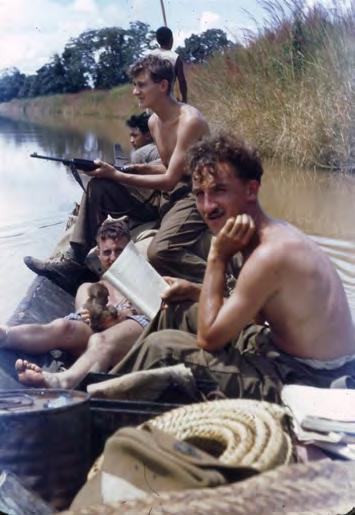
passport photographs which allowed me to verify the identity of the few individuals in question. I was then inspired to curate display-sized posters, integrating a few of the better color photos, my father’s dates and notes, and appropriate excerpts from George Rock’s History
The William Boardman Kinter Collection, originals and digitized output, shipped in its entirety from my home in Alaska to the AFS Archives in New York in June 2015. Through the work of New York University student Andrea Kutsenkow, who interned in the AFS Archives in the spring of 2016, the scanned photographs are now all available online! You can view all the photographs through the AFS Archives website at afs.metarhythm.com/archon/ index.php?p=digitallibrary/ thumbnails&collectionid=149. The names of the AFS volunteers depicted in the collection can be searched through the archival database used to display the images.
It has been a gift to me to study and share my father’s 18-year-old volunteer observations and images, an experience I hope members of other AFS families may enjoy of their loved ones!

 1. William Boardman Kinter waiting for casualties in Burma in 1945. Kinter and his AFS friends referred to themselves as “Marsh’s Marauders,” which they painted in bright yellow on signs placed on the front stretcher rack of their jeep ambulances.
Photograph by Danny Moor.
2. Marion Kinter looking through her father’s scrapbook during a visit to the AFS Archives in February 2016.
3. Coming up the Loikaw River in the fall of 1945 with a monkey and men from Force 136, a branch of the British Special Operations Executive that helped supply resistance movements in enemyoccupied territory. Photograph by William Boardman Kinter.
4. Padaung women in a village four miles west of Pekon in the fall of 1945. Photograph by William Boardman Kinter.
1. William Boardman Kinter waiting for casualties in Burma in 1945. Kinter and his AFS friends referred to themselves as “Marsh’s Marauders,” which they painted in bright yellow on signs placed on the front stretcher rack of their jeep ambulances.
Photograph by Danny Moor.
2. Marion Kinter looking through her father’s scrapbook during a visit to the AFS Archives in February 2016.
3. Coming up the Loikaw River in the fall of 1945 with a monkey and men from Force 136, a branch of the British Special Operations Executive that helped supply resistance movements in enemyoccupied territory. Photograph by William Boardman Kinter.
4. Padaung women in a village four miles west of Pekon in the fall of 1945. Photograph by William Boardman Kinter.
AFS JANUS • SPRING 2016 • 9 4 3 4 5
5. AFS ambulance drivers E. Charles Burk, Donald Hannan, and Richard Vivian outside a Douglas C-47 Skytrain (a military transport aircraft, which they referred to as a “Dak”) on Masirah Island in the fall of 1945. Photograph by William Boardman Kinter.
The Volunteers: Americans Join World War I, 1914-1919
 by Nicole Milano
by Nicole Milano
AFS is proud to announce the launch of The Volunteers: Americans Join World War I, 1914-1919, a groundbreaking multimedia public history project consisting of a secondary school curriculum and exhibition. This project showcases the important role of U.S. American volunteers in World War I, including the significant work of the American Field Service, and also speaks to the future by highlighting how volunteerism is a key component of intercultural competence and global citizenship education today.
The Volunteers: Americans Join World War I, 1914-1919 Curriculum was launched on March 2, 2016 at the Flanders House in New York City. The event featured keynote speaker Sophie De Schaepdrijver, a distinguished Belgian historian, Associate Professor at Pennsylvania State University, and recipient of the Order of the Crown (Belgium). The event also included remarks by Nicolas Polet, Director of Economic, Academic & Public Affairs at the Flanders House; Vincenzo Morlini, President and CEO of AFS Intercultural Programs; and Margaret Hoover, an
author who spoke about the humanitarian efforts of her great-grandfather, former U.S. president Herbert Hoover, who coordinated the Commission for Relief in Belgium during World War I. Photographs and a video from the exciting launch event can be found at thevolunteers.afs.org/ teacher-toolkit/news-and-events
The free curriculum contains 22 lesson plans within six broader topic areas,
which are aligned with both UNESCO Global Learning and U.S. Common Core educational standards. The lesson plans use unique historical photographs, documents, and stories from archives and museums throughout the U.S. and France, and explore engaging and relevant questions regarding motivations and types of volunteer service. The lesson plans offer opportunities for students to analyze the history of World War I through the lens of volunteer service, both before and after the period of American neutrality. Many of the lesson plans can be adapted to different national contexts, and aim to continue the legacy of volunteerism established during World War I by encouraging students to engage in local, regional, and international service. The lesson plans can be used in secondary school courses about U.S. History, World History, European History, American Literature, Global Literature, Economics, Global Issues, and Global Leadership and Social Change.
The Volunteers Curriculum was created by AFS Intercultural Programs, together with a distinguished Curriculum Development Committee of historians,

AFS JANUS • SPRING 2016 • 10
“There is an extraordinary story embedded in World War I that risks being completely lost on generations, if it weren’t for efforts like this.”
—Margaret Hoover Author and Great-Granddaughter of Herbert Hoover
educators, and archivists. The lesson plans were developed in partnership with the National World War I Museum and Memorial and Primary Source, a non-profit resource center dedicated to advancing global education. AFS was honored to receive an official endorsement for the project from the U.S. World War I Centennial Commission, based in Washington, D.C.
The curriculum is complemented by a related exhibition, which opened at the National World War I Museum and Memorial in Kansas City, Missouri on April 5, 2016. This special panel exhibition was produced in partnership with AFS, and will be featured at the Museum through October 2, 2016 before traveling to other venues.

The curriculum was generously supported by the General Representation of the Government of Flanders to the USA. Principal funding for the exhibition was given by The Florence Gould Foundation, with additional generous support from Associazione Intercultura onlus, Fondazione Intercultura onlus, the General Representation of the Government of Flanders to the USA, the Jessie Smith Noyes Foundation, Inc., the New York Council for the Humanities, Richard Spencer, and the Wilder-Guiles Family in memory of Amos N. Wilder. Visit thevolunteers.afs.org to learn more about the project and download the curriculum!
1. The Volunteers explores how humanitarian efforts were organized and sustained during World War I. This image shows school children eating food provided through the Commission for Relief in Belgium, coordinated by Herbert Hoover. Commission for Relief in Belgium Records, Box 627, Photo 379. Courtesy of the Hoover Institution Library & Archives, Stanford University.
2. American nurses assisting wounded soldiers during a meal in the jaw ward of a hospital in Neuilly-sur-Seine, France. The Volunteers includes information about women’s volunteer efforts and how they were connected to campaigns for political equality in the United States. Courtesy of the National Library of Medicine.

3. The Volunteers highlights fascinating stories from individual volunteers, including that of Eugene Bullard (pictured above.) Bullard volunteered with the French Foreign Legion and Franco-American Flying Corps, becoming the first African-American pilot in the process. Courtesy of the National Museum of the American Air Force.

4. Loading an American Field Service (AFS) ambulance in France. The Volunteers emphasizes the significant humanitarian contributions made by the AFS volunteers, and places them within the broader historical context.

AFS JANUS • SPRING 2016 • 11
2 3 4
“During World War I, the founding of AFS was an important part of a significant volunteer movement to support the Allies. The Volunteers engages new insights into why Americans would volunteer in the war zone and the role they played well before their country decided to enter the war.”
—PD Dr. Axel Jansen Deputy Professor of American History, Frankfurt University
From Trenches to Bridges: 2015 Youth Forum in Alsace

 by Milena Miladinović
by Milena Miladinović
The international youth forum From Trenches to Bridges brought 200 young people from 43 nationalities to Strasbourg, France between October 31 and November 6, 2015, to learn about volunteerism and active global citizenship from World War I to the present day. Organized by Access Alsace, AFS France, AFS Germany, and AFS Switzerland, with the assistance of AFS International, the forum was supported by 60 AFS volunteers from 10 countries.
Strasbourg, located in the French region of Alsace and situated on the Rhine River across from Germany, was chosen for its significant history and location. The region was under German possession during World War I, after France lost the region during a previous war. Alsace now demonstrates how France and Germany can live alongside each other peacefully after a period of bitter conflict. The forum participants began their week by crossing the footbridge spanning the Rhine River between France and Germany, symbolizing the friendship that developed between the two countries after the World Wars.
The youth forum participants had a chance to reflect on the meaning
of volunteerism and active global citizenship throughout the week. The significance of World War I and the role of the American Field Service was a strong component of the event, and participants learned about the World War I ambulance drivers through immersive lectures and site visits, and saw a reconstructed World War I ambulance. They visited the preserved trenches at Hartmannswillerkopf, where
they were given a tour by local guides. The young participants also heard a moving speech given by a family member of Richard Hall, the first AFS ambulance driver who was killed during the battle of Hartmannswillerkopf, who reflected on Richard’s volunteer efforts a century after his death.
One of the key moments for the participants was meeting Shabana Basij-Rasikh, who attended school
AFS JANUS • SPRING 2016 • 12 1
2
secretly under the Taliban regime and later created the School of Leadership in Afghanistan. Her practical experience in identifying problems and making positive changes in her own community as a young, active global citizen was one of the crucial takeaways for the participants. On AFS and the mission of the organization today, Shabana noted: “I think physical exchange is very important, especially at this young age when young people still are forming their values, and understanding or trying to understand the world around them, and when you expose them to travel and to different cultures, to places where they’re not familiar with, that’s where they broaden their understanding, their vision for the world.”
From Trenches to Bridges culminated with a multimedia Peace Charter drafted by the participants and handed over to a representative of the European Parliament on the final day of the forum. The drafting process provided an opportunity for them to reflect on what they learned throughout the week about volunteerism and active global citizenship from World War I to the present day, and to respond to two key questions:
1. What are the biggest challenges that we face in living together peacefully today?
2. What can we, as active citizens and future leaders, do to tackle these challenges?
The participants worked together in small groups with their volunteer trainers to respond and offer concrete solutions, and their answers were compiled by the youth forum team into a final charter. The document version of the Peace Charter can be found on the following page, while the video version featuring the participants can be found at youtube.com/watch?v=NUpI4MU8KZY
AFS is dedicated to creating active global citizens, and the youth forum participants indicated their preparedness in tackling the challenges that keep us from living together peacefully. Active global citizenship is more than just a sense of belonging to a broader community; it is also the active linking of the local with the global, taking concrete actions and relating to others while being aware of interdependence and connections across the globe. >>>
1. Youth forum participants read short biographies of American Field Service volunteers provided by the AFS Archives, and discussed why young people volunteered during World War I and why they choose to volunteer today. To learn more about the impressions of the participants, volunteers, and organizers of the youth forum, visit youtube.com/watch?v=o8-PfQrLmac
2. AFS volunteers Edouard Verté, Miriam Lenk, and Antonia Hillberg wait for participants arriving at the train station in Strasbourg.
3. Youth forum participants at the bridge crossing between France and Germany.

4. Tunisian AFS participant Asma Ayed reads excerpts from “Walk Together, Talk Together,” a poem inspired by an ancient Sanskrit proverb. The poem has been popular as a song with AFSers around the world since the 1950s.
Photograph (following page): Youth forum participants with the family of Richard Hall at the Council of Europe, an important regional intergovernmental organization, which aims to promote human rights, democracy, and the rule of law in its 47 member states, covering 820 million citizens

AFS JANUS • SPRING 2016 • 13
3 4 4
Photographs by Guillaume Kerhervé. Courtesy of AFS Vivre Sans Frontière.
Peace Charter Let’s Build a Better World Together
We, the more than 200 students from 43 nationalities participating in the From Trenches to Bridges: 2015 Youth Forum in Alsace, have been working together for a week on the history of World War I and the story of AFS, on learning to live together through intercultural learning, and on active citizenship. In intensive workshops, we have discussed the biggest challenges that we face in living together peacefully today, and what we, as active citizens and future leaders, can do to tackle these challenges. We are presenting our answers to you, the European Parliament, in the form of this multimedia Peace Charter.
The biggest challenge that we feel is keeping us from living together peacefully is the lack of understanding for others. Different understandings of the world can lead to disagreements and misunderstandings. However, the biggest factor for conflict lies in the lack of understanding of cultural and religious
differences, giving way to stereotypes and racism. We experience a lack of empathy, which prevents us from seeing each other as fellow human beings.
Another big challenge that we see in the world is the ignorance about current events and global issues, and the lack of education regarding these topics. We are especially concerned about the lack of education regarding culture, religion, poverty, gender, racial and sexual inequality, as well as socioeconomic and environmental issues.
We are also concerned about corruption and the lack of compromise among the leaders of our communities, the abuse of power, and the negative consequences stemming from old conflicts that have yet to be resolved.
We feel that the path to tackle these issues lies in promoting tolerance and acceptance. We should be aware of, and celebrate, the differences between us, but at the same time also look past them to the things we all share. This
can be done by increasing intercultural exchanges, by sharing spaces and a culture of open communication, and by building friendships with people of diverse backgrounds.
Another way to solve the challenges that we face is through education and raising awareness. We want accessible quality education for young people worldwide, and more school and community events to promote awareness about current world events and other important issues. We are also committed to sharing our own knowledge with others and making a conscious effort to educate ourselves. We also feel that it is important to question everything, to engage in critical thinking, and to look at things from all sides.
Finally, we need to actively engage and participate in our communities, and strive to become role models and leaders. We need to dare to create change, and remember that each and every one of us can make a difference in the world

AFS JANUS • SPRING 2016 • 14
Charles Franklin Cole passed away on August 16, 2013, at age 91. Cole volunteered with AFS between February 1944 and July 1945, serving in the Italian Campaign. After the war, he graduated from Williams College and worked for the J.C. Penney Company. Cole was preceded in death by his wife of 51 years, Nancy. He was survived by his son, daughter, and three grandchildren.
Gerald Boyd Conley passed away on October 26, 2012, at age 89. He was sent overseas in January 1945, serving in the Italian and France-Germany Campaigns as an ambulance driver with the American Field Service before returning to the United States in 1945. Conley was survived by his daughter, Marcia, son, Christopher, and two granddaughters, Meg and Kate.
Dwight Mills Cooper passed away on April 27, 2013, at age 87. He was sent overseas in March 1945 as a volunteer with AFS, and took part in the Italian Campaign. He was scheduled for duty with the Southeast Asia Command in the India-Burma theater of war, but due to cessation of wartime hostilities he returned to the United States in November 1945.
George A. Ebelhare, Jr. passed away on June 9, 2015, in Florence, Colorado at age 89. He was sent overseas with AFS in July 1944, serving in the Italian and FranceGermany Campaigns before returning to the United States in July 1945. Ebelhare received a degree in journalism after the war, and became a strong advocate for historic preservation. He is survived by his children.


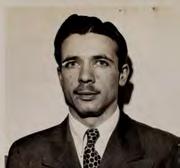

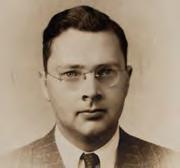
Joseph Fromm (originally spelled “From”), a veteran foreign correspondent and former editor of U.S. News & World Report, passed away on May 10, 2014, at age 94. Fromm was sent overseas with AFS in February 1943, serving in North Africa and Italy before his repatriation in June 1944. He is survived by his son, two daughters, nine grandchildren, and five great-grandchildren.
Howard Clifford Mayhew passed away on June 24, 2015, at age 88. Mayhew was sent overseas with AFS in February 1945. He was transferred from the France-Germany theater of war to India in July, and owing to the termination of war with Japan was repatriated in October 1945. He is survived by his wife, three children, seven grandchildren, and four great-grandchildren.

Henry Bradley Reynolds passed away on June 21, 2013, at age 95. Reynolds founded and was CEO of HomeTech Information Systems for 47 years. He volunteered for AFS in April 1942, serving in the Middle East theater of war before returning home in July 1943. He was survived by his wife of 33 years, three daughters, three grandchildren, and two great-grandchildren.
Russell Maynard Schupp passed away on November 5, 2014, at age 90. Schupp was sent overseas with AFS in October 1944, and took part in the Italian Campaign before his repatriation in November 1945. Schupp worked as a printer for his local newspaper after the war. He is survived by his wife of 62 years, three daughters, seven grandchildren, and five great-grandchildren.
Gayle Lee Smith passed away on May 20, 2015, at age 91. He volunteered for the American Field Service at age 19, and was sent overseas in April 1943. He served in the Burma Campaign until his return to the U.S. in September 1944. He went overseas again with AFS in November 1944, serving in the France-Germany Campaign until his repatriation in July 1945.


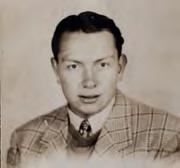
AFS WWII Ambulance Drivers Last Post
Charles F. Cole (CM 61)
George A. Ebelhare, Jr. (CM 88)
Henry B. Reynolds (ME 16)
Gerald B. Conley (CM 94, IB 60-T)
Joseph Fromm (CM 40)
Russell M. Schupp (CM 92, IB 59-T)
Dwight M. Cooper (CM 97, IB 59-T)
Howard C. Mayhew (CM 96, IB 60-T)
AFS JANUS • SPRING 2016 • 15
Gayle L. Smith (IB 1, FR 4)
Arthur Howe, Jr. Endowment Fund and Archival Project
by Nicole Milano
AFSIntercultural Programs established the Arthur Howe, Jr. Endowment Fund in honor of our late colleague and friend this past year. Art was a volunteer ambulance driver during World War II, president of AFS from 1965 to 1971, and a life trustee until his passing in 2014. This fund will be used to provide scholarships to students on the traditional school exchange programs throughout the AFS Network, programs that Art himself guided and nurtured during his life long association with AFS.
In addition to the endowment fund, AFS created the Arthur Howe, Jr. Archival Project. Art and his family donated a historic collection to the AFS Archives consisting of World War II letters, notes on the evolution of the student exchange programs, wartime artifacts, photographs with U.S. presidents,
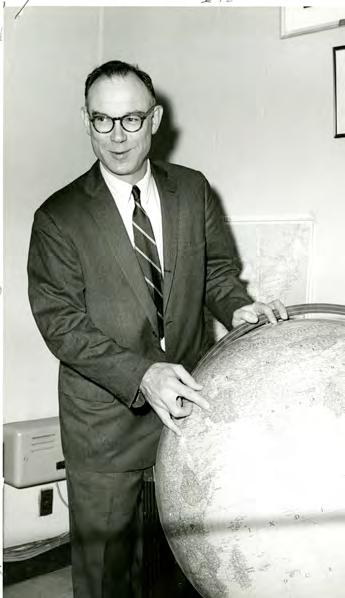
and other unique material. The diverse topics covered within the collection will also be of use to students, academics, filmmakers, museum curators, and others hoping to learn more about AFS.
Art was an integral part of AFS from its beginnings to its role as a catalyst for peace in our world today, and his lifelong commitment to creating a more just and peaceful world is admirable and an example for us all. Please consider making a taxdeductible donation using the enclosed envelope to the Arthur Howe, Jr. Endowment Fund and Arthur Howe, Jr. Archival Project, so that Art’s commitment will be remembered by AFSers and many others for years to come. If you would like to discuss making an online donation or other financial contributions, please contact Paul Gamner at +1.212.209.0916.
71 West 23rd Street, 6th Floor New York, NY 10010, USA
Arthur Howe, Jr. pointing to Iran on a globe during his AFS presidency in 1967.
All photographs in this issue are courtesy of the Archives of the American Field Service and AFS Intercultural Programs (AFS Archives) unless otherwise noted. The holder of copyright for some of these items may be unknown. Please contact the AFS Archives if you can help identify the copyright holder(s).











 Cover: French stretcher-bearers unloading the wounded from an AFS ambulance at the hospital in Moosch, Alsace.
1. Richard Hall in 1915. Courtesy of the Dartmouth College Archives.
2, 3, & 4. Richard Hall prior to his service with AFS. Courtesy of the Hall family.
5. SSU 3 ambulance drivers wearing gas masks in Alsace in 1915.
Cover: French stretcher-bearers unloading the wounded from an AFS ambulance at the hospital in Moosch, Alsace.
1. Richard Hall in 1915. Courtesy of the Dartmouth College Archives.
2, 3, & 4. Richard Hall prior to his service with AFS. Courtesy of the Hall family.
5. SSU 3 ambulance drivers wearing gas masks in Alsace in 1915.






 1. AFS ambulances on the road leading up to Hartmannswillerkopf in 1915.
2. Richard Hall, Louis Hall, and fellow AFS driver Tracy Putnam at a car park in Mollau in 1915. Louis married a French woman, Helen Iselin, and lived in France for years after the war.
3. Richard Hall’s destroyed ambulance.
4. AFS founder A. Piatt Andrew at Hall’s grave in Moosch during the war.
1. AFS ambulances on the road leading up to Hartmannswillerkopf in 1915.
2. Richard Hall, Louis Hall, and fellow AFS driver Tracy Putnam at a car park in Mollau in 1915. Louis married a French woman, Helen Iselin, and lived in France for years after the war.
3. Richard Hall’s destroyed ambulance.
4. AFS founder A. Piatt Andrew at Hall’s grave in Moosch during the war.









 by Marion A. Kinter
by Marion A. Kinter



 1. William Boardman Kinter waiting for casualties in Burma in 1945. Kinter and his AFS friends referred to themselves as “Marsh’s Marauders,” which they painted in bright yellow on signs placed on the front stretcher rack of their jeep ambulances.
Photograph by Danny Moor.
2. Marion Kinter looking through her father’s scrapbook during a visit to the AFS Archives in February 2016.
3. Coming up the Loikaw River in the fall of 1945 with a monkey and men from Force 136, a branch of the British Special Operations Executive that helped supply resistance movements in enemyoccupied territory. Photograph by William Boardman Kinter.
4. Padaung women in a village four miles west of Pekon in the fall of 1945. Photograph by William Boardman Kinter.
1. William Boardman Kinter waiting for casualties in Burma in 1945. Kinter and his AFS friends referred to themselves as “Marsh’s Marauders,” which they painted in bright yellow on signs placed on the front stretcher rack of their jeep ambulances.
Photograph by Danny Moor.
2. Marion Kinter looking through her father’s scrapbook during a visit to the AFS Archives in February 2016.
3. Coming up the Loikaw River in the fall of 1945 with a monkey and men from Force 136, a branch of the British Special Operations Executive that helped supply resistance movements in enemyoccupied territory. Photograph by William Boardman Kinter.
4. Padaung women in a village four miles west of Pekon in the fall of 1945. Photograph by William Boardman Kinter.
 by Nicole Milano
by Nicole Milano






 by Milena Miladinović
by Milena Miladinović












